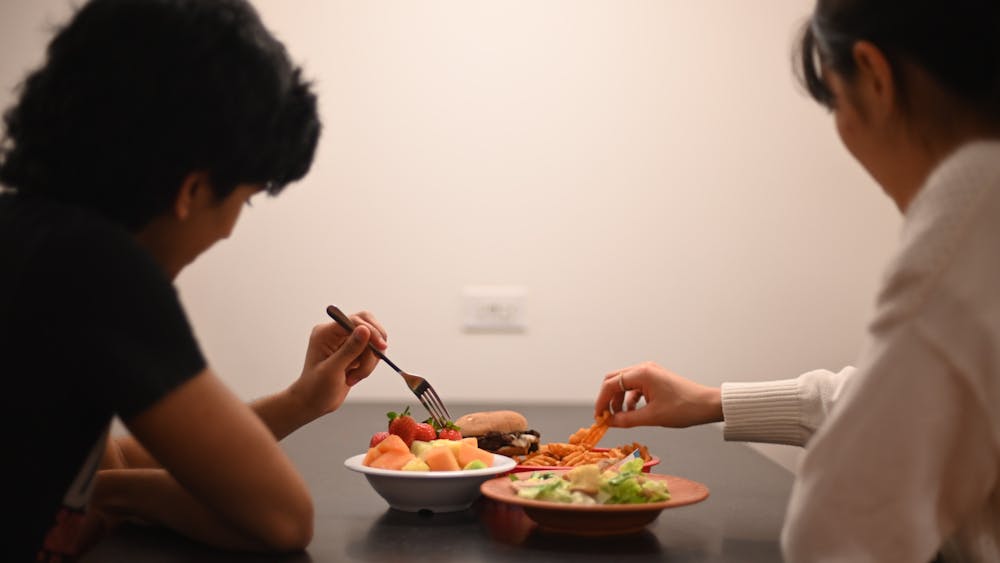My world began at a kitchen table. Over plates of sticky rice and empanadas, I learned about language and culture. When my parents discussed elections, I learned about politics and government. I was taught expectations and manners here: Don’t move your legs; don’t slurp your food; don’t eat before your dad does. The kitchen table taught me the persistently frustrating art of family conversations, and chores at the table taught me responsibility. Throughout my life, I’ve hated, adored, feared, and respected this sacred spot, but then it was gone.
Nowadays, we’ve relegated food to the blank spaces of our Google Calendars: the 20 to 30 minute gaps between club meetings and recitations. It isn’t uncommon to see students shoveling food, with heads buried in lecture slides or a YouTube video. The era of to–go boxes and frozen pastas, however, isn’t just a facet of the Penn lifestyle but a global phenomenon. For example, in South Korea, the average citizen eats more than half of their meals alone. They’ve even coined the phrase “honbap,” which stems from the words for alone and rice, for the increasingly common experience. Moreover, surveys have demonstrated that half of adult American meals are consumed alone. It seems as if cultures that have traditionally seen food as an invaluable tool of connection and familial bonding have forsaken their culinary gatherings.
The current pop culture depiction of the kitchen table is relatively recent. In the United States, the dining experience that began in Thomas Jefferson’s Monticello eventually reached the middle class, and solidified itself as a symbol of the stability of a nuclear family as periods of financial instability and wartime uncertainty overtook the country. The birth of the kitchen table in American pop culture was intertwined with Victorian–era expectations of piety and patriarchy. The 1950 educational film A Date with your Family highlights the disturbing qualities of the utopic family dinner. Mothers and daughters were expected to change outfits to be more presentable. It was their responsibility to construct the relaxation and dignification that characterized life at the kitchen table by looking “relaxed, rested, and attractive.” Here, in this designated space, the family was to assume their designated roles and do so happily. “The table is no place for discontent,” said the film.
Moreover, the kitchen table perpetuates these stringent and exclusionary societal standards that it was made of. The idealized family in this space should be headed by a hard–working father and the mother. The children are sandwiched in between on each side. The table was seen as an epitome of mid–20th century American values. And, as such, the inability to achieve such a docile dining experience was then synonymous with being un–American. Households with absent fathers, working mothers, or single adults were excluded from the canon of the American dinner. In fact, for many, the kitchen table has been characterized by a deficit or a lack rather than those that are actually present.
The work to deconstruct the kitchen table began not long after its creation. In 1974, Louise Bourgeois embodied this with her sculpture The Destruction of the Father. In this piece, a tyrannical and misogynistic father—at the head of a kitchen table—is overtaken by the family he oppresses and cannibalized. In television, shows like The Sopranos, which follows the family and work life of mob boss Tony Soprano, highlighted the less demure and sometimes unpleasant sides of dinner conversations. As more diverse artists illuminate more diverse families engaged in authentic interactions, the pristine image of the happy 1950s family sitting around the table began to rot away.
There is an undeniable stigma around eating alone, but that also stems from the exclusionary nature of the kitchen table. Food is made to be enjoyed regardless of who is there to accompany the eater. The new wave of solo supper–goers may reflect increasing loneliness in a digital age, but they also are re–empowering themselves and are redefining what food means, outside of the kitchen table. Food has always stood for connection, but it should not be constrained to only one type that excludes cultures, lifestyles, and authenticity.
And yet in lieu of physical connection, we’ve created an equally complex digital culture around dinner. On YouTube, influencers began getting millions of views for "mukbangs": food challenges where they would consume immense portions of food. The authentic nature of these eating videos has enabled the viewer to feel as though the influencer is dining with them. Also, apps like FaceTime enable long–distance connections, so people can now eat with those that wouldn’t be able to join them at a physical table.
While the kitchen table of our collective memory is gone, we’ve adapted to create a new one in its place. It’s not exactly a table but a composite of kitchen counters, dining hall linoleum, and car seat consoles. We have kept the same people that sat at the old one, but we’ve expanded it. YouTubers and true crime detectives sit across from us, while long–distance friends and family are beside us. The past and present and hopes of the future collide where we sit, amongst the ghosts of those who left us and glimmers of who is yet to come.







